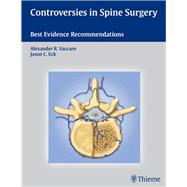
Controversies in Spine Surgery: Best Evidence Recommendations
by Vaccaro, Alexander R., M.D., Ph.D.Rent Textbook
Rent Digital
New Textbook
We're Sorry
Sold Out
Used Textbook
We're Sorry
Sold Out
How Marketplace Works:
- This item is offered by an independent seller and not shipped from our warehouse
- Item details like edition and cover design may differ from our description; see seller's comments before ordering.
- Sellers much confirm and ship within two business days; otherwise, the order will be cancelled and refunded.
- Marketplace purchases cannot be returned to eCampus.com. Contact the seller directly for inquiries; if no response within two days, contact customer service.
- Additional shipping costs apply to Marketplace purchases. Review shipping costs at checkout.
Summary
Table of Contents
| Introduction | |
| Introduction | |
| Trauma | |
| Cervical Spine | |
| Clearing cervical spine injuries – MRI, dynamic x-rays, CT | |
| Type II odontoid fractures – surgery versus conservative, anterior versus posterior approach, role of Halo | |
| Management of cervical facet fractures – surgical indications and approach | |
| Management of cervical facet dislocations – role of MRI, timing of reduction, anterior versus posterior approach | |
| Thoracolumbar Spine | |
| Thoracolumbar burst fracture – surgery versus conservative care | |
| Vertebral compression fracture – surgery versus conservative care, does augmentation increase future fracture risk, vertebroplasty vs. kyphoplasty | |
| Spinal Cord Injury | |
| Use of steroids for spinal cord injury | |
| Role of early surgical decompression for spinal cord injury | |
| – Degenerative | |
| Cervical Spine | |
| Cervical myelopathy – anterior versus posterior approach, timing of surgery, meaning of MRI signal changes | |
| Adjacent level cervical degeneration – effect of fusion, sagittal alignment, plate position | |
| Thoracolumbar Spine | |
| Adult low grade spondylolisthesis – conservative versus surgery, surgical approach, role of fusion, role of instrumentation | |
| Surgery for low back pain – surgical approach, discogram, facet injections | |
| Recurrent lumbar disk herniation – repeat discectomy vs. fusion | |
| Management of thoracic disk herniation | |
| – Technology | |
| Rigid versus dynamic cervical plates – indications and efficacy | |
| BMP in the cervical spine – efficacy and associated risks | |
| Role of cervical disk replacement - Does it avoid the shortcomings of a fusion? | |
| Role of lumbar disk replacement - Does it avoid the shortcomings of a fusion? | |
| Minimally invasive lumbar fusion – results and complications compared to open techniques | |
| The meaning of MRI findings with regards to posterior ligamentous disruption and stability in the setting of trauma | |
| Use of neuromonitoring in spinal surgery - indications | |
| – Infection | |
| BMP in the setting of infection – indications, risks and efficacy | |
| Spine infections – medical vs. surgical treatment options | |
| Table of Contents provided by Publisher. All Rights Reserved. |
An electronic version of this book is available through VitalSource.
This book is viewable on PC, Mac, iPhone, iPad, iPod Touch, and most smartphones.
By purchasing, you will be able to view this book online, as well as download it, for the chosen number of days.
Digital License
You are licensing a digital product for a set duration. Durations are set forth in the product description, with "Lifetime" typically meaning five (5) years of online access and permanent download to a supported device. All licenses are non-transferable.
More details can be found here.
A downloadable version of this book is available through the eCampus Reader or compatible Adobe readers.
Applications are available on iOS, Android, PC, Mac, and Windows Mobile platforms.
Please view the compatibility matrix prior to purchase.
